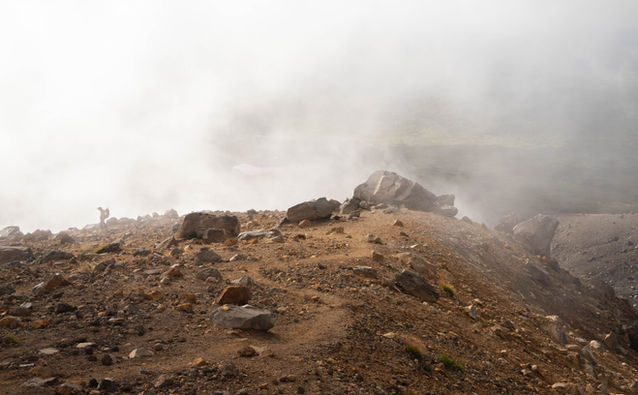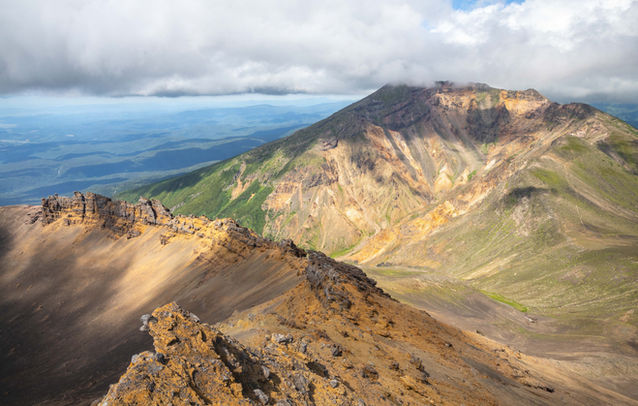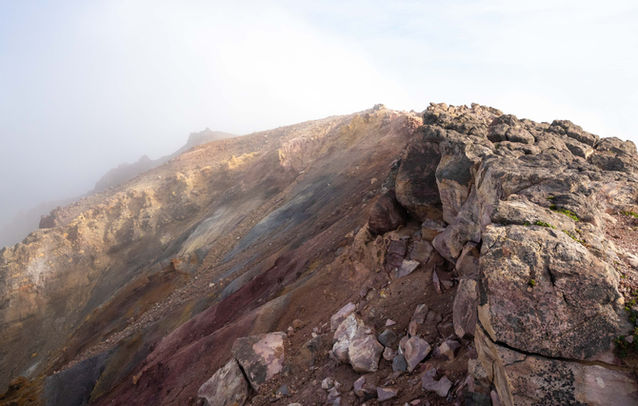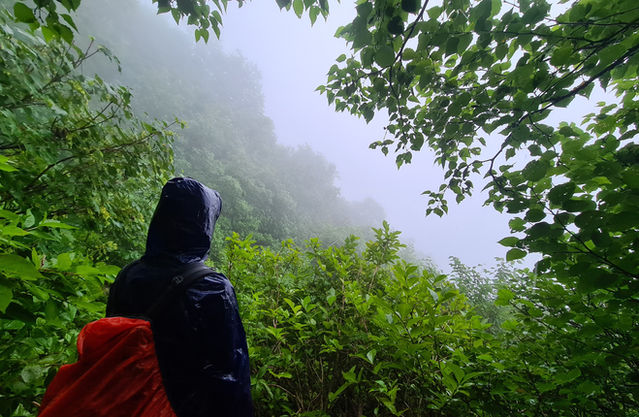
A complete guide to hiking in Hokkaido
Hyakumeizan
9
Trails Featured
6
Best Season
July - August - Sept.
Highest Elevation
2290m
Overview
Hokkaido is an alluring destination for those seeking to escape the human influence that's found on most of mainland Japan (Honshu). It contains the highest amount of natural forests in all of Japan, unspoiled by the cedar plantations that cover much of the mainland. It also contains more wildlife than the rest of Japan, with regular sightings of foxes, deer, squirrels, and sometimes even brown bears. The hiking trails often provide more peace and fewer people than the popular hikes back in the Japanese Alps. And although its most famous attraction is the huge amount of snowfall, the 3 warmest months in Hokkaido offer the most comfortable climate for summer hiking in Japan. If you desire a change of pace from the other incredible mountains near Tokyo and Osaka, Hokkaido is the perfect option, with its own unique landscape and environment.
There are many amazing hikes in Hokkaido, a truly complete guide would be far too big for one webpage, so this guide will only focus on the Hyakumeizan. There are 9 Hyakumeizan in Hokkaido and these mountains are the most common reason for hikers to visit during the summer.
In This Article
1. General
1.1 - Access
1.2 - Weather & Seasons
1.3 - Cautions & Bears
1.4 - Useful Links
2. Featured Hikes
2.1 - Daisetsuzan
2.2 - Mt. Tokachi and Biei
2.3 - Mt. Meakan
2.4 - Mt. Shari
2.5 - Mt. Rausu
2.6 - Mt. Yotei
3. Remaining Hyakumeizan
3.1 - Mt. Poroshiri
3.2 - Mt. Tomuraushi
3.3 - Mt. Rishiri

Climbing the river on the trail to Mt. Shari
Access
To Hokkaido
Flights are the best option from major cities and relatively cheap, often costing less than ¥10,000 one-way. The airport is located in New Chitose which is 40 min from Sapporo by train. You can compare prices here.
To The Hiking Trails
Renting a car is the best and sometimes the only option for accessing the hiking trails in Hokkaido. Although it can be expensive, you can offset the cost with car camping if you choose a vehicle with foldable rear seats. This can be requested when you go to pick up your car. You can compare prices and make reservations here, prices can be as low as ¥4000 – ¥6000.
Cycling around Hokkaido is quite popular, like most of Japan there can be a lot of rain during summer so some preparation is needed.
Public Transport in Hokkaido is not ideal for most of the hiking trails. But if you don't mind multiple connections and the odd taxi fare then you'll be fine. Hitch-hiking is legal in Japan and safer than other countries, but there are laws against disturbing traffic so be respectful when choosing this option.
Weather and Seasons
Summer and autumn, from July to September, are the best times for hiking in Hokkaido. There is likely to be snow hanging around until July. The autumn leaves will be colourful from late-September. The first snowfall usually occurs in Daisetsuzan in October.
For weather forecasts, mountainforecast.com and the nearest town's forecast are a good combination for a fairly accurate picture. The weather is quite unpredictable though, so the forecast is only a guide, you should always be prepared for rain or storms.
This need for adequate preparation for storms in Hokkaido is painfully evident by two incidents involving hyperthermia in summer, one involving a hiker in Daisetsuzan (full story here) and the other involving 8 people on Tomuraushi (full story here).
Cautions & Bears
Drinking Water
One of the things you'll notice when travelling Hokkaido is the wildlife, and especially foxes, they're everywhere. For hikers, this means we can't drink any water from rivers and streams. Why? There is a risk of Echinococcosis, a potentially fatal parasitic disease that comes from fox poo, which is carried into the rivers after rainfall. So all water from these sources needs to be boiled or properly treated (adequate filter).
Ticks
Occasionally, you might encounter ticks while hiking in Japan, and due to the wildlife in Hokkaido this can be a bit more common. Although rare, three tick-born diseases have been slowly growing in the last 15 years: Lyme disease, Japanese spotted fever, and the SFTS virus. The later two are quite rare, however, Lyme disease is somewhat common if you happen to be bitten by a tick and don't remove it promptly. Make sure to check yourself regularly, and see a doctor if you're concerned after getting bitten. There is no cure for Lyme disease once it's established, but antibiotics are an effective method of treatment if taken early before the disease takes hold. You can read more about Lyme disease and it's prevention here.
Bears
There are more bears in Hokkaido than anywhere else in Japan, but luckily, it's unlikely you'll see them while hiking unless you're in the back country or hiking up Mt. Rausu. Hokkaido is also the only place in Japan where you'll find large brown bears, which require more caution than the smaller black bears. They're most active from September when they start preparing for hibernation. The effectiveness of bear bells is questionable (read an analysis here), but the effectiveness of bear spray is well documented. Standard bear safety should be practised while hiking in Hokkaido, including carrying bear spray. You can read an overview of bear safety tips here.
Useful links


Featured Hikes
Trail Summary
The Daisetsuzan Volcanic Group is a mountain range located in the heart of Hokkaido and features 3 of Japan's famous 100 mountains: Tomuraushi, Tokachi, and the tallest peak in Hokkaido, Asahidake. Most commonly when people refer to hiking Daisetsuzan they are referring to the highest peak, Asahidake. There are numerous options for hiking the peak, the 3 most popular options are: an out-and-back hike that takes about 5 hours, a 7 hour loop hike that includes the natural Nakadake onsen, and the 8 hour traverse from Asahidake to Kurodake. All of these hikes start from the Asahidake Ropeway.
Gallery

十勝岳
Elevation: 2077m
Trail Summary
Elevation Change
➚ ➘ 1550m
Mt. Tokachi is a large and active volcano in Daisetsuzan National Park, it's part of the Hyakumeizan and is often hiked as a loop trail that includes Mt. Biei. Mt. Biei is a neighbouring peak and a highly recommended inclusion for the Mt. Tokachi hike because this is where the most enjoyable terrain and the most stunning views are found. However, if you are short on time, you can do either mountain as an out-and-back day hike which will take about 6 hours.
Gallery

Trail Summary
Mt. Meakan is an incredible active volcano located in the Akan-Mashu National Park, the hike is famous for it's smouldering crater, pristine lakes, and twin volcanic peaks. The hike is best completed as a loop which includes Akan-fuji, due to the stunning views of Meakan from the Akan-fuji peak. There are two options for the trailhead, one that starts from a lakeside campground, and the other which starts from an onsen at the base of Meakan.
The Akan-Mashu National Park features many other attractions such as nice onsens, hotels, and the stunning Lake Mashu. Other great hikes in the park include Mt. Oakan and the Lake Mashu crater hike.
Elevation Change
➚ ➘ 1100m
Gallery

Trail Summary
Mt. Shari is a magnificent mountain located between Mt. Meakan and Mt. Rausu. The trail features a stunning variety of terrain which includes multiple river crossings, some mild rock climbing, beautiful forests, waterfalls, gorgeous ridgeline paths, and steep mountain peaks surrounded by picturesque farmland. Over half of the hike meanders up the river which requires careful footing or water shoes, and extra consideration regarding rainfall. The hike is not that difficult, but requires extra consideration due to all of those river crossings. There is a nice mountain hut at the entrance to the trail, the friendly manager speaks some English and also does regular trail maintenance. The return trail detours around a gorgeous ridgeline which adds more variety to the hike.
Elevation Gain
➚ ➘ 950m
Gallery

Trail Summary
Mt. Rausu is the highest mountain located on the Shiretoko Peninsula, which is famous for having the highest population of brown bears in Japan. The peak is renowned for its high winds and has a spectacular 360-degree view. The terrain is mostly a forest trail half of which consists of a small creek bed which can be quite difficult on rainy days, with the top section of the hike featuring large boulders. Aside from bears, there is an abundance of wildlife here and it's quite common to see dear and foxes during your hike. Bear spray can be rented for ¥2000 at the mountain hut located next to the trailhead, this is highly recommended as there are frequent bear sightings on the trail.
Elevation Change
➚ ➘ 1450m
Trail Summary
Mt. Yotei is the most iconic mountain in Hokkaido, closely resembling the prominent classical shape of Mt. Fuji. It serves as a picturesque backdrop to the popular ski resorts in the winter, and offers enjoyable hiking in the summer. The forests around Yotei are quite beautiful and contain an abundance of wildlife, it's common to see chipmunks, woodpeckers, and foxes during your hike. Bear sightings are quite rare but occasionally happen. The views at the top can be spectacular on a clear day, hiking around the crater is quite fun with some large boulders for climbing and it adds some variety to the views, but can also be skipped depending on your stamina. The hike data provided above includes the rim, which adds an extra hour.
The Remaining Hyakumeizan

There are 3 remaining hyakumeizan I wasn't able to cover during my 10-day trip to Hokkaido. I've included a summary below and links to other websites with hike descriptions.
Mt. Poroshiri
Time: 2 Days
Distance: 25 km
Elev. change: ➚ ➘ 2600m
Trail info and photos: LostFilipina.com
One of the most difficult hikes to plan, there is no public transport, it requires 2 days hiking, and has an hour of river crossings which are impassable after moderate rainfall. There is a nice mountain hut on the ridge which can be booked in advance online. This one is also known for bears and ticks.
%20Mt_%20Poroshiri.jpg)
Mt. Tomuraushi
Time: 2 Days
Distance: 22 km
Elev. change: ➚ ➘ 1650m
Overnight hike: AllTrails.com
Mt. Tomuraushi is part of the Daisetsuzan mountain range and commonly done as part of multi-day hike that includes Asahidake, the highest peak in Daisetsuzan. It can also be done as a multi-day hike along with Tokachi and Mt.Biei. Alltrails has provided info for the shortest option which is an overnight hike from Tomuraushi Onsen. Given the numerous options for Tomuraushi, it would be best to buy the comprehensive hiking map to help with your planning. You can buy the map from Amazon.

Image: Google maps
Mt. Rishiri
Time: 9 Hours
Distance: 12-17 km
Elev. change: ➚ ➘ 1510m - 1670m
Trailhead 1: yamakei-online.com
Trailhead 2: LostFilipina.com
Mt. Rishiri might be the most difficult hike to get to in Japan. It's located across the ocean on a volcanic island at the northern most point of Hokkaido. There are two main trails, with a mountain hut about 2 hours from the summit if you wish to spend the night.

Image: Japan-Guide.com
Related Articles


























































